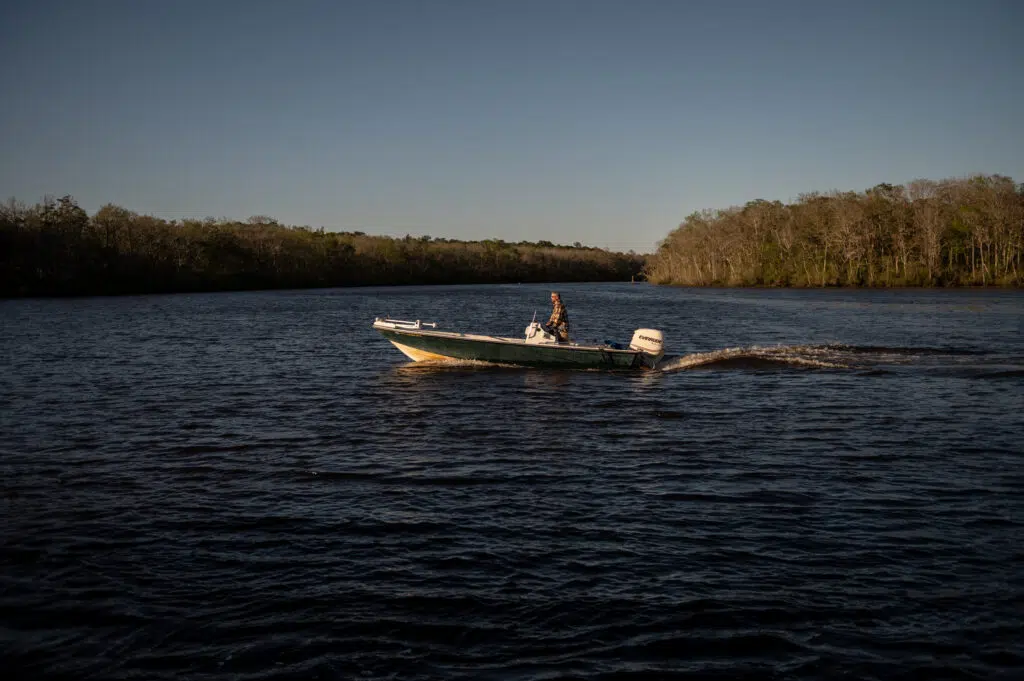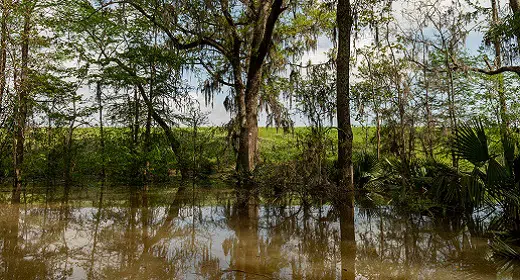by Isabelle Chapman: A predawn phone call woke Ron Bledsoe with a jolt. It was his supervisor telling him to come in…
Bledsoe dressed and drove an hour to the power plant, near Kingston, Tennessee, where he worked. He arrived at a shocking sight: A mountain of coal ash covering the road and a set of railroad tracks. It looked like the surface of the moon, he recalled.
Hours earlier, an embankment at the plant had ruptured, flooding the area with gray muck. The spill was an environmental calamity, and the fallout was immediate. The ash blanketed up to 400 acres, killed hundreds of fish, damaged more than a dozen homes and polluted nearby waterways. The clean-up took years and cost more than $1 billion.
Coal ash, an umbrella term for the residue that’s left over when utilities burn coal, is one of the United States’ largest kinds of industrial waste. It contains metals — such as lead, mercury, chromium, selenium, cadmium and arsenic — that never biodegrade. Studies have shown these contaminants are dangerous to humans and have linked some to cancer, lung disease and birth defects.
For a time, the Kingston incident catapulted coal ash into the public consciousness. But experts say it continues to pose a massive threat throughout the country.
About 400 miles southwest of Kingston, a coal ash lagoon — which holds almost four times as much sludge as what spilled in Tennessee — is sitting in the Mobile–Tensaw Delta, one of the most biodiverse areas of the United States, with flora and fauna not known to exist anywhere else on Earth. Environmentalists, community members and scientists fear the pond could someday unleash a Kingston-like catastrophe on southern Alabama and say leaving the coal ash in the delta is shortsighted and dangerous.
“We’ve got an A-bomb up the river,” John Howard, who lives in Mobile County and said he has been fishing in southern Alabama for decades, said. “It’s just waiting to happen.”
The Mobile–Tensaw Delta, in southern Alabama, is one of the most biodiverse areas of the United States, with flora and fauna that exist nowhere else on Earth. Matthew Gannon/CNN
‘Horror’ scene in Kingston
Most Americans had likely never heard of coal ash until three days before Christmas 2008, when the Kingston spill news broke.
Before the 1970s, many utilities pumped their coal ash into the atmosphere, attorney Lisa Evans, who has focused on coal ash litigation for more than 20 years, said. After Congress passed the Clean Air Act of 1970, which regulated power plants’ air emissions, some facilities began storing their coal ash in dirt ditches, commonly known today as ash ponds or surface impoundments.
Hundreds of these sites now dot the country, according to data that federal regulations require pond operators to publish and was compiled by Earthjustice, a nonprofit that handles environmental lawsuits. Because coal plants produce electricity by converting large volumes of water into steam, many of these waste sites are situated near river systems and flood zones. But 40 or fewer have a protective liner to contain the leftover ash, and more than 200 have been shown to contaminate groundwater with toxic substances at levels that exceed federal safety standards, the Earthjustice data shows.
With the Clean Air Act, the nation traded one environmental problem for another, Evans, who works for Earthjustice, said.
“One could see the billowing black smoke,” Evans said. “You can’t see coal ash contaminating underlying groundwater (…) you can’t see the slow pollution of the adjacent river and the dying of the fish (…) It’s likely to be less dramatic.”
After 5.4 million cubic yards of coal ash spilled at the Kingston plant, the Environmental Protection Agency (EPA) designated the area as a Superfund site. The Tennessee Valley Authority (TVA), which owned the plant, spent more than $1 billion over six years to clean up the spill.
The aftermath “was like nothing I’ve ever seen before,” Richard Moore, who served as the inspector general for the TVA at the time, said. “It was like a scene out of a horror movie.”
Tommy Johnson — like Bledsoe, the worker who compared the Kingston spill to the moon’s surface — was at the facility that day. He spent six years working on the clean-up effort and said he believes exposure to the coal ash made him sick.

In 2018, Johnson joined more than 200 plaintiffs in suing Jacobs Engineering, a TVA contractor hired to oversee the Kingston cleanup, alleging Jacobs lied to workers about the ash’s toxicity. Bledsoe was also part of a suit, which was filed in 2013. A jury eventually found that Jacobs failed to keep workers safe during the cleanup and that this failure could have caused the illnesses and injuries they suffered. The parties are now litigating over whether individual workers’ illnesses are a result of coal ash exposure.
“It’s (been) one ailment after another,” Johnson said.
Today, Johnson said, he struggles to breathe and walk. Bledsoe, according to court filings signed by his doctor, suffers from chronic obstructive pulmonary disease, a disease that is typically caused by cigarette smoking. Bledsoe and his doctor have said he was never a smoker.
In a statement, Jacobs spokesperson Heather Byrd told CNN the company “stands by its work assisting TVA with the difficult job of cleaning up the Kingston coal ash spill,” adding that “the evidence will prove that the plaintiffs’ claimed conditions were not caused by exposure to coal ash at Kingston.”
TVA spokesperson Scott Brooks said in a statement that the utility has become an “industry leader in the safe, secure management of coal ash.”
EPA’s ‘tipping point’
In response to the Kingston disaster, the EPA set out to review the condition of more than 500 coal ash ponds across the United States.
“(Kingston) was almost a tipping point,” Mathy Stanislaus, who served as assistant administrator for the EPA’s Office of Solid Waste and Emergency Response from 2009 to 2017, said. “The reaction (at the EPA) was, ‘We need to do something about this.’”
In 2015, the agency implemented its first-ever regulations on coal ash disposal, forcing utilities across the country to begin closure and remediation of ponds that were unlined and contaminating groundwater above permitted levels.
The rule gives such ponds’ owners two closure options: seal the ash through a procedure known as capping-in-place, or dig it up and move it to a lined landfill.
Depending on a pond’s size, the EPA gave utilities between five and potentially 15 years to close them. In 2018, a federal court decision prompted the EPA to amend its rule. Today, some utilities may have until 2036 to complete closure of certain ash ponds.
But environmental advocates say capping-in-place is not always an effective option, especially for ponds where coal ash sits below the water table, the point below which the ground is saturated with water, because the cap does not prevent heavy metals from leaching into the surrounding area. They often point to a 2001 report by the Electric Power Research Institute, in which researchers studied three unlined, closed ponds and found that while groundwater quality improved at two, it didn’t improve at the third, where some ash sat below the water table.
Moreover, they fear that as weather patterns become more extreme and less predictable, leaving coal ash in an unlined pond is reckless because the potential for a catastrophic spill will always loom.
The Mobile–Tensaw Delta, in southern Alabama, is one of the largest river systems in the United States. It has been referred to as “America’s Amazon.” Matthew Gannon/CNN
A nationwide challenge
There are an estimated 511 coal ash ponds in the United States, according to a CNN analysis of the data compiled by Earthjustice. Nearly half — about 46% — are unlined and have been or will be closed in place. The utilities’ self-reported data shows around 160 are known to be contaminating groundwater, but groundwater data gathered by the Environmental Integrity Project, a nonprofit watchdog that advocates for better environmental law enforcement, places that number at closer to 200. It’s unclear how many of those ponds sit below the water table or have direct contact with groundwater, but around 60 sit in a flood zone.
MAPPING COAL ASH PONDS
Geologist Mark Hutson said that because the majority of the ponds are constructed along rivers — and typically in flood plains — many are likely to pollute the groundwater.
“The science points us clearly to excavation as the only way to protect public health and the environment,” Michael Regan, who ran North Carolina’s Department of Environmental Quality and now serves as EPA administrator, said about ponds in that state in 2019.
In the 2015 rule, the EPA declined to regulate coal ash as hazardous waste, instead opting to regulate it as solid waste, a category that can include everything from banana peels and candy wrappers to sewage and industrial sludge. That designation effectively allowed utilities to police themselves unless state regulators or private citizens, which the law gives standing to seek enforcement through the courts, intervened.
Stanislaus, the former EPA assistant administrator, said the agency declined to regulate coal ash as hazardous waste in part because business leaders raised concerns that doing so would hamstring their ability to recycle the substance, which is frequently used in cement, grout and other construction materials, and because officials felt regulating coal ash as solid waste would still adequately prevent it from contaminating air and water.
That decision meant that, initially, states could regulate coal ash through existing water and waste programs. But it was a missed opportunity to enact stronger safeguards, Dalal Aboulhosn, the Sierra Club’s deputy director of policy, advocacy and legal, said.
“If EPA would have decided to regulate coal ash as hazardous waste, we would have gotten the strictest of protections for communities,” Aboulhosn said. “From cradle to grave, we would be looking at coal ash as something that could harm communities and (making) sure it would be disposed of properly.”
In 2016, the federal government reclaimed some oversight when a new law authorized the EPA to review states’ programs for regulating pond closures. For states that didn’t develop their own programs, the law required the EPA to develop one instead.

The EPA must still approve states’ programs, but Evans said lax oversight and vague benchmarks — guidelines the agency published in 2017 say mainly that state programs must be “at least as protective as” federal regulations and should ensure public participation — have given states considerable leeway when regulating coal ash.
“The absence of (federal) requirements has left important criteria up in the air and fails to guarantee important safeguards nationally,” Evans wrote in an email.
When President Joe Biden chose Regan to lead the EPA last December, Evans hoped the pick would usher in more rigorous enforcement. Regan had firsthand experience with the consequences of coal ash pollution; In North Carolina, he led the state’s department of environmental quality in the years following a spill.
In an interview with CNN last week, Regan signaled the Biden EPA will indeed take a firmer stance on coal ash management.
While Regan did not provide specifics, he said the agency is planning to announce details, which he said could include additional regulatory actions, soon. That announcement, Regan said, will give a “clearer picture of how the agency plans to move forward” nationwide.
“We’re pretty far down the road on this and we recognize the sense of urgency,” Regan said.
Sources familiar with the matter, who spoke on the condition of anonymity because the announcement is still being finalized, told CNN they expect it to include decisions on a handful of applications for closure extensions at coal ash ponds across the country and notices to several facilities about compliance obligations.
In the meantime, some state governments have taken it upon themselves and forced utilities to excavate their coal ash pits.
After a broken pipe unleashed more than 46,000 cubic yards of coal ash from a retired power plant on the Dan River in 2014, near Eden, North Carolina, state officials enacted a law forcing the closure of all unlined coal ash ponds in the state, ultimately requiring utilities to recycle the ash or put it in a lined landfill.
And in 2019, a Virginia law required Dominion Energy to excavate more than 27 million cubic yards of coal ash from ponds across the state.
But in other states, including Alabama, utilities still have the option to close ponds through cap-in-place.
‘We love our power company’
Standing behind the wheel of a motorboat in April, Ben Raines, a former newspaper journalist who offers tours of the Mobile–Tensaw Delta, steered with the confidence of a man cruising across the Mediterranean on a yacht.
The Mobile–Tensaw Delta is part of the Mobile River Basin, which drains most of Alabama’s water through the delta, the Mobile Bay and into the Gulf of Mexico. It is one of the largest and most biodiverse river systems in North America; the region is home to at least 35 kinds of orchids and likely more turtle species than any other river system on Earth. At least 30 types of carnivorous plants live in the delta. Raines, who has often referred to the delta as “America’s Amazon,” points out one that eats insects.
Alabama’s ecosystems are particularly diverse because glaciers never covered the state during Earth’s last ice age, unlike large swaths of what is now North America.
The delta is where Alabama Power’s James M. Barry Electric Generating Plant’s smokestacks tower above the treeline. Many refer to the plant, named for the executive who led the utility from 1949 to 1952, as simply “Barry” or “Plant Barry.” It’s about 25 miles north of downtown Mobile, sits on the Mobile River and forms a corridor of industrial facilities. At 597 acres, Barry’s ash pond is nearly as large as the National Mall. A grassy berm, dotted with yellow flowers, lines the property’s edge and separates 21.7 million cubic yards of coal ash from the river.
“Coal ash is sitting there right on the edge of (the delta),” Raines said, occasionally stopping his boat to pluck a plant from the water and marvel at it.
“If there were an accident (…) we would have lost, you know, one of America’s treasures, and a treasure that people are only beginning to understand and explore.”

Alabama Power spent $30 million to construct Barry, which opened in 1954. The plant was intended to meet the area’s rapidly expanding electricity needs. Mobile’s population exploded during World War II as the shipbuilding industry grew, Mark VanLandingham, a population studies professor at Tulane University, said. Mobile was fairly developed by the 1950s; it had 17 movie theaters, four hotels and two daily newspapers. The city, which had about 174,000 residents in 1956, was a manufacturing hub for pulp and paper products, lumber and textiles. A guide to Mobile from 1957 boasted that the city was on its way to becoming one of the “great centers of trade and industry.”
But that didn’t pan out. The city’s population peaked at roughly 200,000 in 1960. As residents moved to suburbs and manufacturing began moving overseas, Mobile’s population, like many other post-industrial cities’, declined, VanLandingham said.
As of 2019, census estimates showed the city of Mobile was home to almost 189,000 people. About 18% of the city’s residents lived in poverty. That share was higher — about 21% — for Black Mobilians, who made up more than half the city’s population.
With about 6,000 employees, Alabama Power is a major employer in the state. It provides energy to roughly 100,000 customers in the city of Mobile. Its corporate parent, Southern Company, owns electric utilities in Georgia and Mississippi and is the third largest electric utility company in the country by market value.
In a state where storms are commonplace, “the most important person who shows up at our door after a hurricane is the Alabama Power guy who has just turned our lights back on,” said Casi Callaway, who grew up in Mobile and spent 23 years as the executive director of Mobile Baykeeper, an environmental nonprofit that aims to protect southern Alabama’s waters.
“We love our power company,” she said.
Alabama Power’s choice
Alabama Power is poised to close the Barry pond through capping-in-place. Its process, according to the closure plan filed with state environmental regulators last year, would remove water from the pond to shrink its footprint by nearly half before filling the perimeter with soil and sealing the ash with a cover made from plastic, crushed rock and artificial turf that the company has said is designed to “virtually eliminate infiltration of surface water.”
Records show the site has been contaminating groundwater for years. In its most recent groundwater monitoring report, from 2020, Alabama Power revealed elevated levels of arsenic and cobalt near the Barry plant that exceeded groundwater protection standards by more than eight times and more than five times, respectively. In 2018, state officials fined the company $250,000 for arsenic pollution, saying the company had “caused or allowed the unpermitted discharge of pollutants associated with ash pond wastewater from the Plant Barry Ash Pond to waters of the State.”
In a document filed with the state’s utility regulator last month, company officials acknowledged environmental groups’ concerns about the cap-in-place method’s effectiveness toward protecting groundwater and that “the risk of an adverse outcome remains,” but wrote the company believes its plans for Barry’s ash pond and about 10 other coal waste sites in the state meet federal requirements and that requiring full ash removal would “dramatically” increase costs and “adversely impact” nearby residents’ quality of life through “decades of constant truck traffic.”

“It’s about the money,” Moore, the former TVA inspector general, who now lives near Barry, in Baldwin County, said. “I believe the corporate culture and the corporate mindset at most utilities is the same way: If they can do it on the cheap, that’s what they’re going to do.”
Alabama Power has estimated that it will spend about $860 million to close the Barry ash pond by capping it in place and an additional $36 million for post-closure maintenance, according to its closure plan. Jack Bonnikson, a company spokesperson, declined to say what the company estimated excavation would cost.
But no excavation cost would compare to cleaning up a spill, Evans, the environmental attorney, said.

“It is infinitely cheaper to scoop ash out of a pond and truck it to a lined landfill than to excavate it out of a river and out of people’s yards,” she said.
Frank Holleman, a senior attorney at the Southern Environmental Law Center (SELC) who has litigated against utilities over coal ash contamination for over a decade, said utilities often misrepresent how much each method will cost.
“As a general rule, they overstate the cost of excavation and they understate the cost of cap-in-place,” Holleman said.
In addition, Holleman said utilities often prefer capping-in-place to avoid the “managerial hassle” of transporting coal ash.
In written responses to CNN, Bonnikson challenged Holleman’s claim. He said cost estimates often change as work on a project progresses and that the engineers and geologists who develop cost estimates are expected to adhere to professional standards.
Closing these ponds has sometimes come at a high price for utilities, though often their customers are footing large shares of the bill.
Duke Energy, for example, has estimated it will spend $8 billion to $9 billion to comply with North Carolina’s law and excavate 31 ponds in that state, in addition to four in South Carolina.
Bill Norton, a spokesperson for Duke Energy, couldn’t say how much of that total pertained to the North Carolina ponds. But he said it made up “the vast majority” of the multibillion-dollar estimate and that about $3.8 billion — or at least 40% — will be passed on to North Carolina retail customers.
But customers’ payments aren’t just going toward the cost of pond closures. They’re also lining shareholders’ pockets.
Because many utilities operate as natural monopolies where state regulators control prices, the companies’ profits often depend on how well they control costs. In 1923, the US Supreme Court ruled that to ensure that utilities remain financially sound and can continue to provide services, they should be entitled to recoup the costs of certain investments and profit from them.
Utility regulators and courts are supposed to make sure such investments are reasonable and necessary and that the costs passed onto customers are appropriate.
But Dave Rogers, a deputy director at the Sierra Club, said they are often politicized and customers don’t always get “a fair shake.” Jim Lazar, a senior adviser at the Regulatory Assistance Project, said the result is that today’s customers end up paying for earlier generations’ mistakes.

It’s unclear how much Alabama Power stands to profit from the Barry closure. Bonnikson declined to provide a figure, but a recent filing with the state’s public service commission outlined financial information related to how the company will comply with government mandates next year.
Anna Sommer, a consultant at Energy Futures Group who has advised groups working toward improving Alabama’s public utility regulation process, reviewed the filing for CNN and estimated that the utility would likely return around $200 million to shareholders in the coming years as a result of the Barry pond closure. Sommer’s assessment was reviewed by two ratemaking experts for CNN: Lazar and Stephen Hill, an independent consultant who has provided expert testimony in ratemaking cases.
DEBATING ALABAMA POWER’S PLAN
In an email, Bonnikson said the utility’s annual filings “transparently provided estimated costs for compliance and associated rate calculations.” He declined to comment on Sommer’s estimate, saying only that the utility “will not validate estimates or calculations (CNN) may have received from a third-party group.”
In March, community members, environmentalists and coal industry advocates gathered at a Hampton Inn in Saraland, a Mobile suburb near Plant Barry, for a public hearing to comment on Alabama Power’s closure plan.
Some speakers, including Jonathan Hale, who runs an Alabama-based mining company, supported the utility’s plan. Hale said he was concerned that transporting the waste to a landfill could lead to ash spills on roads and put unnecessary wear and tear on Alabama’s highways.
Many speakers opposed Alabama Power’s plan. One woman became emotional as she recounted learning there was an unlined coal ash pond near her home. A man compared the Barry pond to a rotting tooth that needs to be taken out, a cancerous skin lesion that should be removed, and mold growing on drywall that needs to be gutted and replaced.
Nicholas Williams, a 29-year-old sales and support representative for a small, online hunting gear retailer, stood at the microphone in a T-shirt and baseball cap.
“Twenty years I’ve been poking around up there looking for deer and hogs and ducks and big ol’ flatheads,” Williams said. “Looking for game, but also looking for the peace that a vast mass of calm waters and cypress trees brings. Looking for a sense of being and perspective that you find when you stand on top of the Indian mounds (…) and realize that you’re really very small in the grand scheme of things.”
For Williams, being in the delta is a way of life. He and his wife, Sarah, bought a home perched on Tensaw Lake, a tributary in the delta, three years ago. The couple have chickens in their front yard — the rooster is named Sue, after the Johnny Cash song — and a collection of birds Nicholas has killed is mounted on their living room wall. He said he worries that a spill at Barry could destroy the delta that he hopes to one day share with his children.
“I believe leaving the coal ash pond in place is taking a chance with something that should not be left to chance,” he said. “We don’t have to jeopardize the Mobile–Tensaw Delta.”
While state regulators approved Alabama Power’s plans for the Barry pond in July, EPA Administrator Regan told CNN last month that his agency is “actively investigating (…) the Plant Barry situation.”
“We understand the concerns about this facility in Alabama,” Regan said. “The last administration’s leadership failed to act on these concerns. This administration will act to protect communities and, based on my prior experience, if there is coal ash in contact with groundwater, that’s putting the health and safety of communities at risk and requires our attention.”
‘Nothing God can do’
When Hurricane Ida approached the Gulf Coast in late August, Cade Kistler and the Mobile Baykeeper staff prepared for the worst.
At their downtown Mobile office, they put trash bags over computers and moved them away from windows. They prepared their boat and test tubes to take water samples from the river and check for coal ash. Kistler, Baykeeper’s interim director, made sure his family had enough food in case the power at their home went out.
After the storm made landfall in Louisiana, Kistler drove to Barry to look for signs of damage.
He put a chainsaw in the back of his Subaru in case he needed to cut through fallen trees. The rain was still heavy, he said, recalling how his car shook from the wind as he crossed Mobile Bay on the highway. Kistler, who remembered feeling cautiously optimistic because Ida didn’t directly hit the area, said he didn’t see any signs indicating a disaster had struck Barry.
Meanwhile, Ida was carving a path of destruction across the country, killing at least 80 people across eight states. By any measure, it was one of the strongest tropical storms to ever hit Louisiana.
“We got off really light,” Kistler said. “It really is just a matter of when a similar storm (…) hits coastal Alabama.”
When Kistler and his staff learn a hurricane has formed in the Gulf, they worry about two disaster scenarios at Barry: its dam collapsing or that river water will overtop the dam, sending coal ash surging into the delta.
A coal ash spill wouldn’t be southern Alabama’s first brush with environmental disaster. In 2010, an explosion on a British Petroleum (BP) oil rig in the Gulf of Mexico killed 11 workers and set off a domino effect that caused oil and natural gas to leak into the Gulf for nearly three months.
The Gulf is still recovering from the calamity, which the EPA has called the largest marine drilling-related oil spill in history. As of 2018, researchers were still detecting oil contamination in thousands of fish in the Gulf of Mexico, according to one study.
“You couldn’t walk on the beach,” Mobile resident Madelyn King said. “There were tarballs washing up all the time.”
The BP spill hobbled leisure tourism in the region. Visitor spending in Louisiana dropped by $247 million in 2010, according to a report prepared for the state’s tourism agency by Tourism Economics, a consulting firm that analyzes global travel data.
Callaway, who was leading Mobile Baykeeper at the time (she left Baykeeper for a job as Mobile’s chief resilience officer in May), said southern Alabama dodged a bullet.
“The power of the Mobile River and the delta pushing water out of the bay made sure we didn’t have much oil come into the bay,” Callaway said. “If something happens with the coal ash pit, there’s no natural protection. There’s nothing God can do to protect us from that.”
If the Barry pond were breached, the volume of slurry could eclipse the amount of oil that spilled into the Gulf during the BP disaster.
“They would be dealing with that for God-knows-how-many years,“ Keith Johnston, an attorney for the SELC, said. “It would be devastating for the city of Mobile and the bay. A lot of people rely on that bay for their livelihood.”
When an environmental disaster strikes, Black and Brown communities often suffer the worst consequences, Aboulhosn, the Sierra Club deputy director, said.
“Across the board, communities that are people of color that don’t have the socioeconomic levels of some predominantly White communities are the ones that are shouldering this burden,” she said.
Joe Womack, who grew up in Mobile, runs an environmental advocacy organization in the city’s Africatown neighborhood, a historic Black community that is choked by highways and industrial facilities. He said he worries Africatown, where residents still talk about the ash from a nearby paper mill that would rain down on the community years ago, would continue to bear the brunt of industrial pollution and its consequences.
For “folks that are at the bottom end of the totem pole,” Womack said, “(it’s) just like anything else: You see things happen to you more in a negative sense.”
“The thing with Barry,” he said, is “just more of the same.”
In his remarks to CNN last week, EPA administrator Regan — the first Black man and second person of color to hold the position — called environmental justice and equity “a pillar” for the administration.
“What we’re saying is, ‘We see you, we hear you, and we’re responding,’” Regan said. “Too often, whether it’s the coal ash pond, or a chemical refinery or a landfill, our communities are disproportionately impacted by exposure to pollution.”
The SELC and Mobile Baykeeper have called on Alabama Power to change tack and excavate the pond. The organizations argue the utility’s plan will allow groundwater contamination to continue and that the potential for a disaster will remain if the coal ash is not removed.
Bonnikson declined to say whether the utility has studied how far coal ash might travel if its dam was breached but told CNN in an email that the company’s “structural stability analysis and regular inspections demonstrate the dikes are safe and secure and continue to function as designed.”
In 2010, engineers — hired by the EPA to conduct Barry’s dam safety assessment as part of the national review launched following the Kingston spill — determined that Barry’s dam was in “satisfactory” condition but had a “significant” hazard potential because a failure could cause major damage to the environment, wildlife and habitat if coal ash were released into the river.
Alabama Power has modeled potential flooding in the area with the help of third-party experts, but Bonnikson declined to provide CNN with the data used to run the model. In an email, he wrote that the experts’ models for “extreme river and tropical flood events (showed) no overtopping of the ash pond’s existing dike wall” and that “Even a 500-year tropical flood with an additional 5 feet of storm surge showed no impact on Plant Barry or its ash pond.”
“Since 1965, 15 different tropical storms and hurricanes have passed within 50 miles of the plant site with no impact to plant operations or the ash pond,” Bonnikson wrote.
Storm path data from 1980 to 2020 shows that hurricanes in the Gulf of Mexico aren’t necessarily becoming more frequent, and an analysis of synthetic aperture radar data, which can be used to track how water saturates land, showed no notable flooding near Barry after heavy rainfall. A predictive analysis of flood gauge data at Barry didn’t suggest large deviations from the norm in the coming years.

There is some evidence that more storms are reaching a higher intensity, although there’s some indication that the frequency of storms may be going down, Michael Bell, an atmospheric science professor at Colorado State University, said. In 2020, for example, researchers at the University of Wisconsin in Madison and NOAA looked at nearly 40 years of data and found the probability of storms reaching major hurricane status — Category 3 or higher — increased decade after decade.
Sean Powers, a marine scientist and professor at the University of South Alabama, said changing weather patterns are his biggest concern about the Barry ash pond.
“Everything now is based on our understanding of the risk that exists now,” Powers said.
“Obviously, sea level will rise,” he said. “Storms will increase, at least in intensity if not frequency, and all of those pose serious risk for the release of that material.”

While environmentalists keep an eye out for the next Ida, some scientists say a less visible and more insidious crisis is already underway.
“Eventually, (a disaster) is going to happen,” geologist Mark Hutson, whom the SELC hired to review Alabama Power’s closure plan for the Barry pond last year, said. “In the meantime, there will be decades of slow release of metals into the swampy areas.”
In his report for the SELC, Hutson concluded that to effectively close any coal ash storage site, the waste must be permanently isolated from water, including groundwater, and that the Barry pond’s location — on a meandering river system’s floodplain — was an unsuitable place to permanently store waste.
“No (new) waste disposal facility,” he determined, “would be permitted in this physical location.”












































